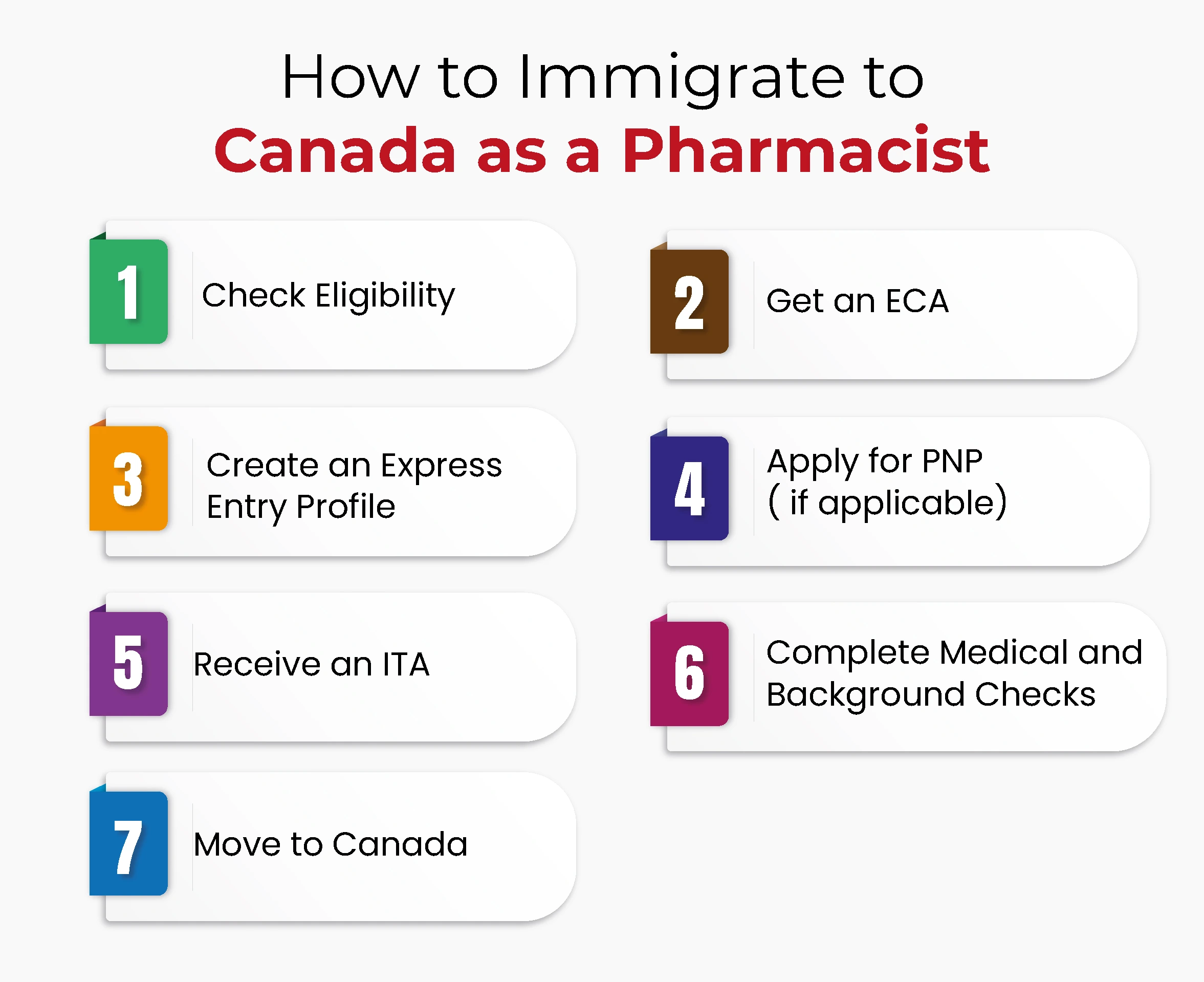Thinking about becoming a pharmacist in Canada?
That’s probably why you’re here, right?
Pharmacists are in high demand, and they play a big role in Canada’s healthcare system. This blog breaks it all down for you- how to become one, what’s required, job opportunities, salary, and how to move to Canada as a pharmacist!
Table of Content
1Is Pharmacist in Demand in Canada2Pharmacist in Canada Requirements3How to Become a Pharmacist in Canada4How to Immigrate to Canada as a Pharmacist5Pharmacist Jobs in Canada6Pharmacist Salary in Canada7Frequently Asked Questions
Is Pharmacist in Demand in Canada
Yes, Pharmacists are in high demand across Canada, especially with the aging population and the growing focus on healthcare. Provinces like Ontario, British Columbia, and Alberta need more pharmacists to keep up with the demand! According to recent reports, 20% of Canadians are aged 65 or older, and 50% of healthcare professionals are above the age of 45 and they are soon planning to retire. By 2030, seniors will make up from 20% to 25% of the population. To support this expansion, the government has announced a $200 billion investment as part of a 10-year plan. The healthcare sector in Canada is experiencing an annual growth rate of 3.3%.
Pharmacist in Canada Requirements
To become a pharmacist in Canada, you basically need a pharmacy degree (BPharm, MPharm, or PharmD). Next need to complete the PEBC certification process, demonstrate language proficiency in English or French, and register with a provincial regulatory body. Requirements may vary slightly by province.
Here is a more detailed breakdown:
Eligibility Criteria
To become a pharmacist in Canada, candidates must meet the following requirements:
- A degree in Pharmacy (BPharm, MPharm, or PharmD)
- Completion of the Pharmacy Examining Board of Canada (PEBC) certification process
- Language proficiency in English or French (IELTS or CELPIP for English)
- Registration with the provincial pharmacy regulatory authority
Documents Required
- Educational transcripts and degree certificates
- PEBC certification
- Proof of work experience (if applicable)
- Proof of language proficiency
- Immigration documents (if applying as a skilled worker)
How to Become a Pharmacist in Canada
To become a licensed pharmacist in Canada, follow the step-by-step process:
1. Obtain a Recognized Pharmacy Degree
Earn a Bachelor of Pharmacy (BPharm) or Doctor of Pharmacy (PharmD) from a recognized institution. Internationally trained pharmacists must have an equivalent degree.
2. Assess Your Credentials (For International Graduates)
Apply to the Pharmacy Examining Board of Canada (PEBC) for credential assessment. Submit academic transcripts and related documents.
3. Pass the PEBC Evaluating Exam (For International Graduates)
If your degree is not from a Canadian-accredited university, you must pass the PEBC Evaluating Exam.
4. Pass the PEBC Qualifying Exam (All Candidates)
This two-part exam includes:
- MCQ (Multiple-Choice Questions)
- OSCE (Objective Structured Clinical Examination)
5. Complete a Structured Practical Training (Internship)
Fulfill the internship requirements set by the province where you plan to practice.Typically includes hands-on experience under a licensed pharmacist.
6. Meet Language Proficiency Requirements
Demonstrate proficiency in English or French (IELTS, TOEFL, or other accepted tests).
7. Register with a Provincial Regulatory Authority
Apply for licensure with the provincial pharmacy regulatory body (e.g., Ontario College of Pharmacists, Alberta College of Pharmacy). Each province has specific requirements, including jurisprudence exams.
8. Obtain Work Authorization (For International Graduates)
Secure a valid work permit or PR (if not a Canadian citizen or resident). Express Entry (Federal Skilled Worker Program) or Provincial Nominee Programs (PNP) can help pharmacists immigrate.
9. Continue Professional Development
Engage in continuous education and certifications as required by the province. Stay updated with regulatory changes.
How to Immigrate to Canada as a Pharmacist
Canada has a high demand for skilled pharmacists, making it an excellent destination for professionals in this field.

Here’s a step-by-step guide to immigrating to Canada as a pharmacist:
1. Check Eligibility for Canada Immigration – Determine if you qualify for Express Entry or Provincial Nominee Programs (PNPs).
2. Get an Educational Credential Assessment (ECA) – Verify your foreign pharmacy degree.
3. Create an Express Entry Profile – If eligible, submit a profile through the Express Entry system.
4. Apply for a Provincial Nomination (if applicable) – Some provinces have special streams for pharmacists.
5. Receive an Invitation to Apply (ITA) – If selected, submit your permanent residency application.
6. Complete Medical and Background Checks – Provide all required documents.
7. Move to Canada and Complete Licensing Process – Once in Canada, fulfill provincial registration and licensing requirements.
Pharmacist Jobs in Canada
Pharmacists in Canada can work in a variety of fields based on their skills and preferences. Depending on interests and skills, you can choose a path that aligns with your passion, whether it’s patient care, research, or the corporate side of healthcare.
Here are some of the most common roles pharmacists take on in Canada:
Community Pharmacist – Works in retail pharmacies, dispensing medications, advising patients, and giving vaccinations.
Hospital Pharmacist – Part of a healthcare team in hospitals, managing medications for inpatients and making sure of safe drug use.
Clinical Pharmacist – Works closely with doctors and nurses to design and monitor treatment plans for patients.
Industrial/Pharmaceutical Company Pharmacist – Involved in drug development, quality control, and regulatory compliance.
Regulatory Affairs Specialist – Works with health authorities to make sure that medicines meet legal and safety standards.
Academic or Research Pharmacist – Engaged in teaching pharmacy students or conducting pharmaceutical research.
Pharmacist Salary in Canada
Pharmacists fall under NOC 31120 (National Occupational Classification). Below is the average annual salary for pharmacists across different provinces:
| Province | Average Hourly Salary (CAD) |
| Ontario | 51.00 |
| British Columbia | 50.00 |
| Newfoundland and Labrador | 48.44 |
| Alberta | 50.50 |
| Prince Edward Island | 53.59 |
| New Brunswick | 49.52 |
| Quebec | 60.77 |
| Saskatchewan | 53.00 |
| Manitoba | 54.00 |
| Nova Scotia | 46.43 |
*This data is as per Dec 3rd 2024 update from Canada job bank*
Becoming a pharmacist in Canada is a rewarding career with strong job prospects and competitive salaries. Whether you’re an Indian pharmacist looking to immigrate to Canada or a student planning to pursue pharmacist courses in Canada, CanApprove consultancy is here to help. With proper preparation and guidance you can build a successful pharmacy career in Canada.





